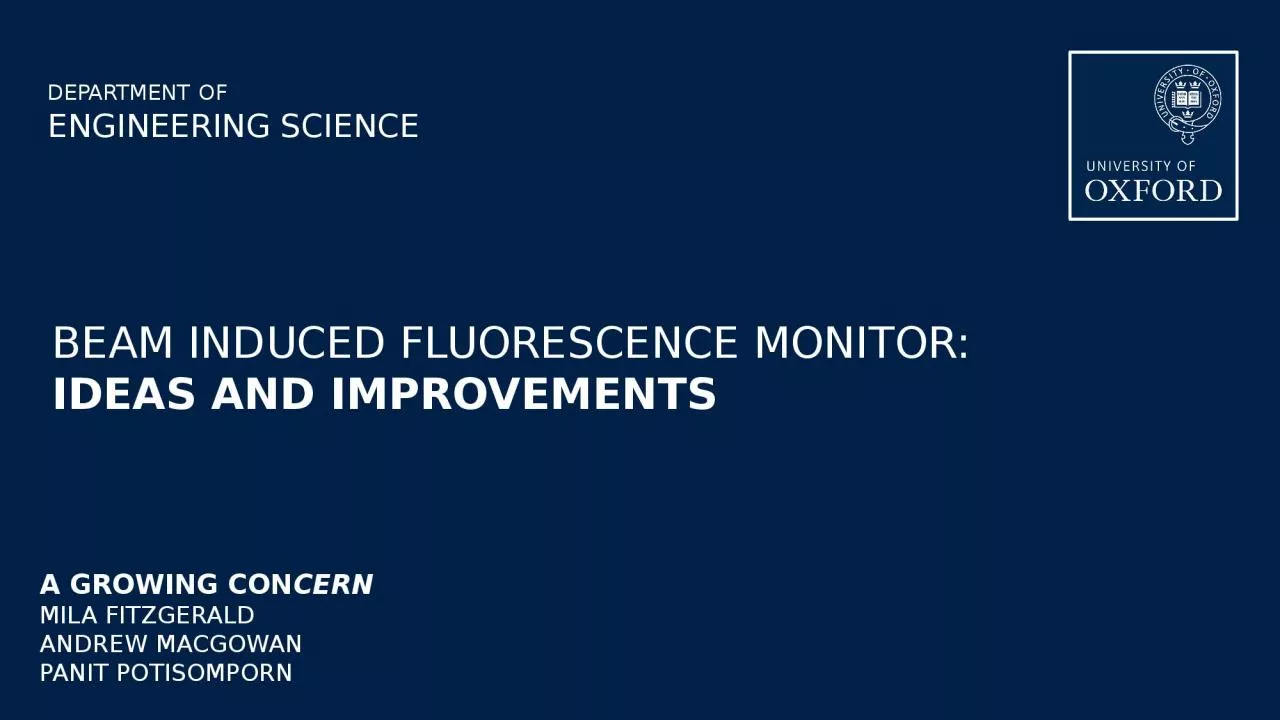

BEAM INDUCED FLUORESCENCE MONITOR IDEAS AND IMPROVEMENTS A GROWING CON CERN MILA FITZGERALD ANDREW MACGOWAN PANIT POTISOMPORN Presentation Agenda Overview The Ideas Questions Overview ID: 918129
Download Presentation The PPT/PDF document "DEPARTMENT OF ENGINEERING SCIENCE" is the property of its rightful owner. Permission is granted to download and print the materials on this web site for personal, non-commercial use only, and to display it on your personal computer provided you do not modify the materials and that you retain all copyright notices contained in the materials. By downloading content from our website, you accept the terms of this agreement.
Slide1
DEPARTMENT
OFENGINEERING SCIENCE
BEAM INDUCED FLUORESCENCE MONITOR:IDEAS AND IMPROVEMENTS
A GROWING CON
CERN
MILA FITZGERALD
ANDREW MACGOWAN
PANIT POTISOMPORN
Slide2Presentation
Agenda
Overview
The Ideas
Questions
Slide3Overview
Our Philosophy
: “Think Outside of the Box”
Panit Potisomporn
Scanning Electron Beam
Electric Field to Shape Charged Flow
Gas Curtain Wire Scanners
Modified Wire Scanners
Fluorescent Microscope
Initial Thoughts
Benefits
Limitations
Next Steps
Slide4Idea:
Scanning Electron Beam
Benefits
Line emission is easier to image than a volume emission
Gets rid of the need for gas jet technology which still requires quite a few optimizations
Used along with confocal imaging technique to ignore background interaction
Limitations and Next Steps
Would the negatively charged electron beam be invasive to the proton beam?
Will electron yield be high enough for detection?
Panit Potisomporn
Initial Thoughts
Find an alternative to the emission volume that is easier to image
Slide5Idea:
Electric Field To Shape Charged Flow
Benefits
Collimates, increasing density and fluorescence rate
Removes developed flow profile dependence on skimmer tolerances
Can use a controller on electric field to counteract pump fluctuations in flow
Reduces spread into vacuum
Limitations and Next Steps
Is it easy to make an ionised gas? Would plasma work?
How to get the electric field into chamber? What strength?
Do ionised gases fluoresce well? What gas species to use?
Controller design
Andrew MacGowan
Slide6Idea:
Mechanical/Electrical Gas Column Wire Scanners
Benefits
Could use some of wire scanner technology
Less intrusive than wire scanner
Faster movement with an electric field over mechanical nozzle movement
Limitations and Next steps
What bits of wire scanner tech could it use?
How to get gas to stay in a column?
How to get the electric field into chamber + how much effect would it have?
Electric field method requires charged gas, which gas species?
How to extract oscillating flow from chamber?
How thin does column need to be?
How to ensure uniform density at interaction point?
Andrew MacGowan
Slide7Idea:
Fluorescent Microscopy
Initial Thoughts
Increasingly popular technology with three general methods used to observe single cells
Could we use this to improve imaging?
Benefits
Ready to use set ups
Three options to choose from
High resolution and accuracy
TIRFM could act as filter
Adaptation to match lens dimensions
Mila Fitzgerald,
Source:
https://www.researchgate.net/publication/291986208
Limitations
Unsure if adequate intensity
Set up size
Untested in application
Next Steps
Is this feasible?
Which set up is best?
Dependent on gas cloud characteristics?
Slide8Idea:
Modified Wire Scanners
Initial Thoughts
Gas curtain non-invasive, could wire scanner be adapted to achieve this?
Solution
Regenerative wire
Move where protons impact
Spool diameter 30 um → 523m wire
Beam width 2.4mm on 60mm wire
Mila Fitzgerald
Slide9Idea:
Modified Wire Scanners
Benefits
Standard results
Cheap and simple
Long life mechanism
Little alteration necessary
Limitations
Relies on surviving one pass
Wire degradation (possible solution → adapt mechanism)
Not gas curtain
Invasive
Mila Fitzgerald, Source:
https://www.researchgate.net/publication/291986208
Next Steps
How many passes?
Degradation levels of wire?
Mechanism development?
Practical issues?
Slide10Worthy Mention:
Extraction Nozzle
Benefits
Easy way to (possibly) collimate flow, increasing density + fluorescence
Reduces reliance on skimmer tolerances for final developed flow
May reduce flow into vacuum
Limitations and Next Steps
How much would it collimate the flow? Needs analysis (CFD)
What size nozzle can you fit in the chamber?
Would a De Laval nozzle be appropriate for cold gases/other conditions like Mach No.?
1
2
Andrew MacGowan
Slide11Worthy Mention:
Mirror Reflection System
Andrew MacGowan
Slide12For the Audience
Any Questions?
Slide13Questions for
CERN
Equation for radial properties of proton beam e.g. current, density?
How fast do we need to image? Cockcroft >1000s
How often is the beam switched off?
How often do wire scanners fail?
Max acceptable beam perturbation?
Slide14Questions for
CERN
What kind of adaptations can be made to the chamber?
What kind of electric field can you generate in the interaction chamber?